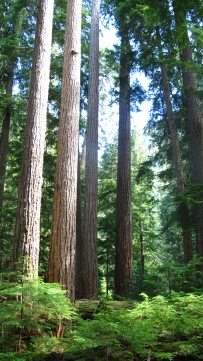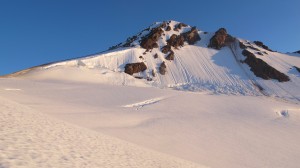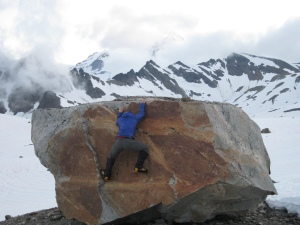After we stashed the bikes at the end of the road, the hike begin on a well-maintained trail along the North Fork of the Sauk River, wandering through an incredible old growth forest that houses some of the biggest trees I’ve ever seen. We spent the first night camping near the historic Mackinaw Shelter and prepared for an early start the next day.
The Gerdine Ridge is a better-than-average moderate volcano route. Most Cascade volcano routes are loose and chossy, while the Gerdine is primarily compacted pumice and somewhat solid rock. All of the tedious scrambling sections are easily bypassed to the east on snow, which I highly recommend. Around 8000′, we left the ridge and traversed northeast on the Gerdine Glacier to an obvious col where it intersects with the Cool Glacier. Easy travel on a largely uncrevassed glacier then led to a pumice saddle, which we used to gain the final headwall, a nice 35 degree snow climb, and hit the top in just five hours from camp!
The descent back down the route was uneventful and presented incredible views from Mt. Stuart to Mt. Adams to the Olympics. Back in camp, we settled in for a fantastic and warm afternoon of napping and eating in preparation for our early start the coming morning. The hike out was surprisingly fast, even with a couple of detours (I have an inability to walk past granite boulders), and a nice nap at the Mackinaw Shelter. The last half hour of the trip was perhaps the most leisurely of all–speeding down a gravel road with a full backpack pushing you along! What an incredible trip!
Glacier Peak climbs are offered from late June to August every year. If you would like to learn more, please contact the American Alpine Institute at 360-671-1505.
--Kurt Hicks, AAI Instructor and Guide











No comments:
Post a Comment